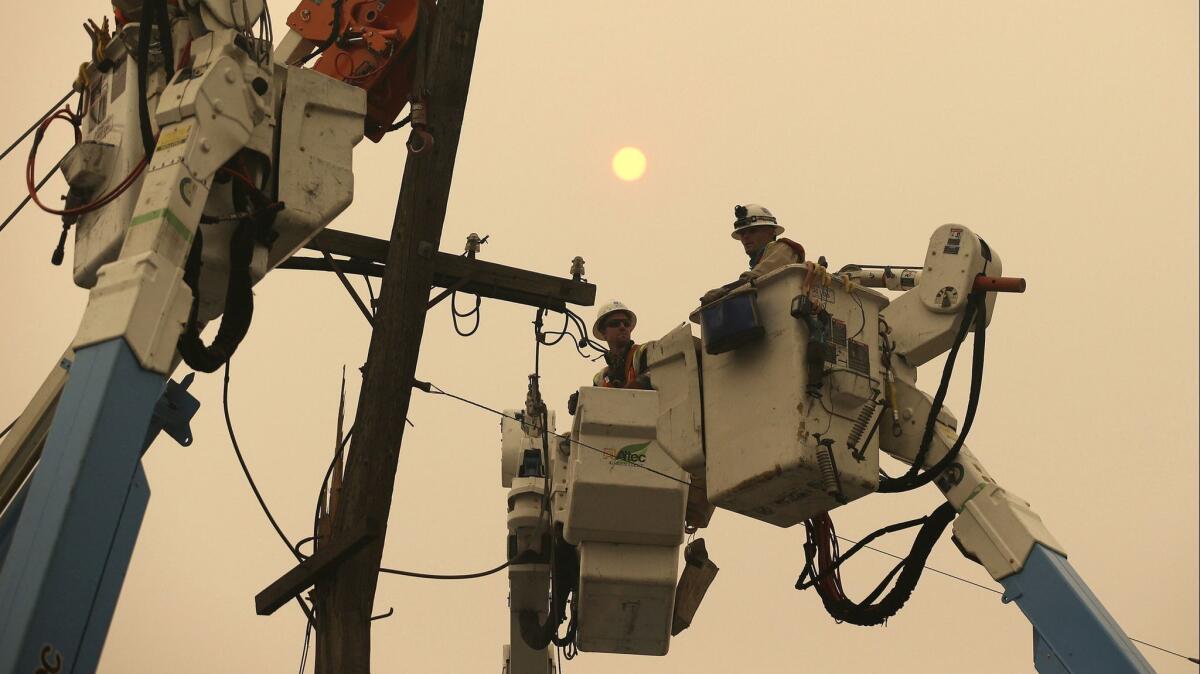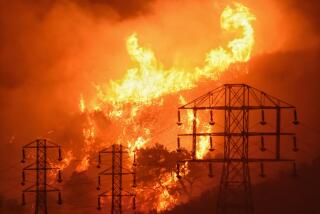Editorial: It’s time to talk about radical changes to California’s utilities

- Share via
It shouldn’t come as a surprise that Pacific Gas and Electric, the state’s largest investor-owned power utility, is on the brink of bankruptcy. On Monday, the company filed a required 15-day notice that it plans to seek financial protection from as much as $30 billion in damage caused by deadly wildfires in recent years that have been linked to its power lines and transformers. But PG&E and the state’s other two large investor-owned utilities, Southern California Edison and San Diego Gas & Electric have been warning for more than a year that their futures are imperiled if they have to pay claims on all of the property and lives lost in wildfires sparked by their equipment — and that was before the massive Camp fire in Northern California and Woolsey fire in Los Angeles and Ventura counties this fall.
The official cause of those blazes is still pending, but both were immediately preceded by reports of malfunctioning electrical equipment nearby. If that’s what is determined to have sparked those fires, PG&E and Southern California Edison, the owners of the equipment, will be on the hook for unfathomably expensive claims.
This is not the beginning of a new energy crisis, however. The lights will not go off in Northern California, most of which relies on PG&E for its power. The utility is reorganizing its debt, not liquidating itself. The power lines won’t be taken down and sold to scrap yards. And there’s no state shortage of electricity or gas. In fact, if anything, the expected bankruptcy process presents an opportunity of sorts because it gives lawmakers the motive and the incentive to rethink the dominant but apparently flawed model for electric power service in the state.
It’s high time we had a frank discussion about whether our current reliance on gigantic profit-making companies makes sense for the state’s future.
Most Californians get their electricity from the three big investor-owned utility companies. (Not Angelenos, though, who have Los Angeles Department of Water and Power, a city-owned utility). Though they are private companies, the IOUs (as they are called for short) are treated like quasi-governmental agencies in some respects. Their rates and profits are regulated by the California Public Utilities Commission. They can’t refuse to serve customers based on fire risk. And they must pay for the losses caused when their equipment destroys property or kills people, even if there was no negligence on their part. With climate change fueling larger and deadlier fires — and ever larger damage claims — this formula has shown itself to be unsustainable.
Last year, the Legislature and governor worked out a deal to allow the utilities to pass on the cost of wildfires to customers if the utility properly maintained its equipment, or if the utility’s financial health would be put into jeopardy by not doing so. Some people called the legislation a bailout for the utilities. We thought it was a reasonable, but still just a first step. One lingering problem is that the state’s major utilities have such huge service areas, the work needed to reduce the wildfire risk posed by their far-flung equipment takes an enormous amount of time and money to complete. The task is complicated by ongoing development into high-fire risk areas.
Gov. Gavin Newsom, to his credit, seems to understand that more needs to be done. Even before PG&E announced its intent to file Chapter 11, Newsom had put together a “strike team” led by his chief of staff Ann O’Leary to start figuring out how to manage what is likely to be a messy bankruptcy and 16 million angry customers.
Enter the Fray: First takes on the news of the minute »
At a news conference Monday, Newsom said that all options were on the table when it comes to the future of PG&E, including breaking up the utility or selling off its assets. We hope he means that, because it does seem that PG&E’s problems extend beyond starting wildfires. The utility was convicted on criminal charges in connection with the deadly natural gas pipeline explosion in San Bruno in 2010, and last month an investigation concluded that the company falsified pipeline safety records between 2012 and 2015.
Critics of PG&E, such as the consumer advocacy group TURN — The Utility Reform Network — and state Sen. Jerry Hill (D-San Mateo), have advocated for radical restructuring, which may include breaking up the utility into smaller companies or selling its assets to public agencies, such as San Francisco’s utilities commission that would have more public accountability. The state has the ability to do this because the California Public Utilities Commission has veto power over the restructuring plan that will come out of bankruptcy. Depending on how it goes, a restructuring could be a boon for the state’s burgeoning Community Choice Aggregation movement, which is a clunky name for a rather simple idea of communities bypassing the big utilities to buy or make their own power without the profit markup.
We don’t know what the best alternative might be. But in light of the last few years and the deadly wildfires, we do know that it’s high time we had a frank discussion about whether our current reliance on gigantic profit-making companies makes sense for the state’s future.
Follow the Opinion section on Twitter @latimesopinion and Facebook
More to Read
A cure for the common opinion
Get thought-provoking perspectives with our weekly newsletter.
You may occasionally receive promotional content from the Los Angeles Times.










